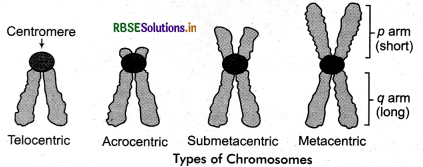RBSE Class 11 Biology Important Questions Chapter 8 Cell: The Unit of Life
Rajasthan Board RBSE Class 11 Biology Important Questions Chapter 8 Cell: The Unit of Life Important Questions and Answers.
RBSE Class 11 Biology Chapter 8 Important Questions Cell: The Unit of Life
Multiple Choice Type Questions
Question 1.
The chromosomes become gradually visible with compaction of chromatin during the meiotic stage:
(a) Diplotene
(b) Leptotene
(c) Zygotene
(d) Pachytene
Answer:
(b) Leptotene

Question 2.
Which one of the following does not differ in E. coli and Chlamydomonas?
(a) Ribosomes
(b) Chromosomal organization
(c) Cell wall
(d) Cell membrane
Answer:
(d) Cell membrane
Question 3.
What is true about ribosomes?
(a) The prokaryotic ribosomes are 80S where ‘S’ stand for sedimentation coefficient.
(b) These are composed of ribonucleic acid and proteins.
(c) These are found only in eukaryotic cells.
(d) These are self splicing introns of some RNAs.
Answer:
(b) These are composed of ribonucleic acid and proteins.
Question 4.
Select the correct statement from the following regarding cell membrane
(a) Na+ and K+ ions move across cell membrane by passive transport.
(b) Proteins make up 60 to 70% of the cell membrane.
(c) Lipids are arranged in a bilayer with polar beads towards the inner part.
(d) Fluid mosaic model of cell membrane was proposed by singer and Nicolson.
Answer:
(b) Proteins make up 60 to 70% of the cell membrane.
Question 5.
Which one of the following cellular part is correctly described?
(a) Thylakoids: Flattened membranous sacs forming the grana of chloroplasts.
(b) Centrioles: Sites for active RNA synthesis.
(c) Ribosomes: Those on chloroplasts are larger (80S) while those in cytoplasm are smaller (70S).
(d) Lysosomes: Optimally active at a pH of about 8.5.
Answer:
(a) Thylakoids: Flattened membranous sacs forming the grana of chloroplasts.
Question 6.
Which one of the following structures is an organelle within an organelle?
(a) Ribosome
(b) Peroxisome
(c) ER
(d) Mesosome
Answer:
(b) Peroxisome
Question 7.
A major site of synthesis of lipid is
(a) SER
(b) Symplast
(c) Nucleoplasm
(d) RER
Answer:
(a) SER
Quesiton 8.
Which of the following criteria does not pertain to facilitated transport?
(a) High selectivity
(b) Transport saturation
(c) Uphill transport
(d) Requirement of special membrane proteins
Answer:
(c) Uphill transport

Question 9.
The Golgi complex play a role in:
(a) In digestion of proteins and carbohydrates.
(b) An energy transferring organelles.
(c) In post translational modification of proteins and glycosidation of lipids.
(d) In trapping the light and transforming it into chemical energy.
Answer:
(c) In post translational modification of proteins and glycosidation of lipids.
Question 10.
Pigment containing membranous extensions in some cyanobacteria are:
(a) Basal bodies
(b) Pneumatophores
(c)Chromatophores
(d) Heterocyst
Answer:
(c)Chromatophores
Question 11.
Peptide synthesis inside a cell takes place in:
(a) Chloroplast
(b) Mitochondria
(c) Chromoplast
(d) Ribosomes
Answer:
(d) Ribosomes
Question 12.
What are the structures called that give an appearence as beads on strings in the chromosomes when viewed under electron microscope?
(a) Genes
(b) Nucleotides
(c) Nucleosomes
(d) Base pairs
Answer:
(c) Nucleosomes
Question 13.
In eubacteria, a cellular component that resembles eukaryotic cell is:
(a) Plasma membrane
(b) Nucleolus
(c) Ribosomes
(d) Cell wall
Answer:
(a) Plasma membrane
Question 14.
In mitochondria, protons accumulate in the:
(a) Outer membrane
(b) Inner membrane
(c) Intermembrane space
(d) Matrix
Answer:
(c) Intermembrane space
Question 15.
Which of the following is not considered as a part of the endomembrane system:
(a) Golgi complex
(b) Peroxisome
(c) Vacuole
(d) Lysosome
Answer:
(b) Peroxisome
Question 16.
Important site for formation of glycoproteins and glycolipids is:
(a) Vacuole
(b) Golgi apparatus
(c) Plastid
(d) Lysosome
Answer:
(b) Golgi apparatus
Question 17.
The cell membrane of adjacent cells are fused at:
(a) Macula adherens
(b) Zonula adherens
(c) Zonula occludens
(d) Nexus
Answer:
(c) Zonula occludens
Question 18.
When the chromosome has a centromere nearer to one end of the chromosome resulting into one shorter and one longer arm, the chromosome is termed as:
(a) Metacentric
(b) Sub - metacentric
(c) Acrocentric
(d) Telocentric
Answer:
(b) Sub - metacentric
Question 19.
Detailed structure of the membrane was studied after the advent of electron microscope during:
(a) 1930’s
(b) 1950’s
(c) 1970’s
(d) 1990’s
Answer:
(b) 1950’s

Question 20.
Plant cells normally lack:
(a) Ribosomes
(b) Golgi bodies
(c) Centrioles
(d) Cell membranes
Answer:
(c) Centrioles
Question 21.
Thylakoids occur inside:
(a) Mitochondria
(b) Chloroplast
(c) Golgi apparatus
(d) Endoplasmic reticulum
Answer:
(b) Chloroplast
Question 22.
Mitochondria are semi autonomous as they posses:
(a) DNA
(b) DNA + RNA
(c) DNA + RNA + Ribosomes
(d) Protein
Answer:
(c) DNA + RNA + Ribosomes
Question 23.
Which of the cell organelle lacks membrane?
(a) Mesosome
(b) Mitochondria
(c) Ribosome
(d) Liposome
Answer:
(c) Ribosome
Question 24.
What is mitoplast?
(a) Membrane less mitochondria.
(b) Another name of mitochondria.
(c) Mitochondria without outer membrane.
(d) Mitochondria without inner membrane.
Answer:
(c) Mitochondria without outer membrane.
Question 25.
Cell theory is not applicable for:
(a) Bacteria
(b) Fungus
(c) Algae
(d) Virus
Answer:
(d) Virus
Question 26.
Digestive enzymes hydrolases are present in:
(a) Vacuoles
(b) Lysosomes
(c) Golgibodies
(d) Mitochondria
Answer:
(b) Lysosomes
Question 27.
Na+/K+ pump in a cell is an example of:
(a) osmosis
(b) diffusion
(c) passive transport
(d) active transport
Answer:
(d) active transport
Question 28.
Aleuroplasts in a cell store:
(a) Starch
(b) Oils
(c) Proteins
(d) Nutrients
Answer:
(c) Proteins
Question 29.
House keeping proteins occur in:
(a) E.R.
(b) Golgi complex
(c) Cytoskeleton
(d) All of these
Answer:
(d) All of these
Question 30.
The cell membrane of adjacent cells are fused at this cell function:
(a) Macula adherens
(b) Zonula adherens
(c) Zonula occludens
(d) Nexus
Answer:
(c) Zonula occludens

Question 31.
The number of microtubules in a flagellum including those sharing three protofilaments with each other is:
(a) 11
(b) 20
(c) 22
(d) 10
Answer:
(b) 20
Question 32.
The microfilaments in eukaryotic cells are madeup of:
(a) Actin
(b) Albumin
(c) Globulin
(d) Fibrin
Answer:
(a) Actin
Question 33.
Which of the following features is common to prokaryotes and many eukaryotes?
(a) Chromosomes present
(b) Cell wall present
(c) Nuclear membrane present
(d) Sub cellular organelles present
Answer:
(b) Cell wall present
Question 34.
Who proposed the fluid mosaic model of plasma membrane?
(a) Camillo Golgi
(b) Schleiden and Schwann
(c) Singer and Nicolson
(d) Robert Brown
Answer:
(c) Singer and Nicolson
Question 35.
Tonoplast is:
(a) Outer membrane of mitochondria.
(b) Inner membrane of chloroplast.
(c) Membrane of vacuole in plant cell.
(d) Cell membrane of plant cell.
Answer:
(c) Membrane of vacuole in plant cell.
Question 36.
Which of the following is not true for a eukaryotic cells:
(a) It has 80S type of ribosome present in mitochondria.
(b) It has 80S type of ribosome present in cytoplasm.
(c) Mitochondria contain circular DNA.
(d) Membrane bound organelles are present.
Answer:
(a) It has 80S type of ribosome present in mitochondria.
Question 37.
Plastids differ from mitochondria on the basis of one of the following features. Mark the right answer:
(a) Presence of two layers of membrane.
(b) Presence of ribosome.
(c) Presence of chlorophyll.
(d) Presence of DNA.
Answer:
(c) Presence of chlorophyll.
Question 38.
Which of the following is not a function of cytoskeleton in a cell?
(a) Intracellular transport.
(b) Maintenance of cell shape and structure.
(c) Support of the organelle.
(d) Cell motility.
Answer:
(a) Intracellular transport.
Question 39.
The stain used to visualise mitochondria is:
(a) Fast green
(b) Safranine
(c) Acetocarmine
(d) Janus green
Answer:
(d) Janus green
Question 40.
Which one of the following structures between two adjacent cells is an effective transport pathway?
(a) Plasmalemma
(b) Plasmodesmata
(c) Plastoquinones
(d) Endoplasmic reticulum
Answer:
(b) Plasmodesmata
Question 41.
Which one of the following has its own DNA?
(a) Peroxisome
(b) Mitochondria
(c) Dictyosome
(d) Lysosome
Answer:
(b) Mitochondria
Question 42.
The main arena of various types of activities of a cell is:
(a) Nucleus
(b) Plasma membrane
(c) Mitochondria
(d) Cytoplasm
Answer:
(d) Cytoplasm
Question 43.
An elaborate network of filamentous protein tubular structures forming skeleton of cell in cytoplasm are:
(a) Thylakoid
(b) Endoplasmic reticulum
(c) Plasmalemma
(d) Microtubules
Answer:
(d) Microtubules
Question 44.
Racker’s particles occur in:
(a) Chromosomes
(b) Nucleus
(c) Golgi complex
(d) Mitochondria
Answer:
(d) Mitochondria
Question 45.
Which one is not a constituent of cell membrane:
(a) Proline
(b) Phospholipids
(c) Cholestrol
(d) Glycolipids
Answer:
(a) Proline
Question 46.
Robert Hooke gave the term cell in the year:
(a) 1660
(b) 1665
(c) 1805
(d) 1960
Answer:
(b) 1665

Question 47.
Structural elements of cell wall are:
(a) Microtubules
(b) Arabinogalactans
(c) Microfibrils
(d) Microfilaments
Answer:
(c) Microfibrils
Question 48.
Lysosomes, the suicide bags, were first discovered by:
(a) De Duve
(b) Golgi
(c) Hooke
(d) Purkinje
Answer:
(a) De Duve
Question 49.
The two subunits of ribosome remain united at a critical level of:
(a) Manganese
(b) Calcium
(c) Copper
(d) Magnesium
Answer:
(d) Magnesium
Question 50.
Which is not a plastid?
(a) Chloroplast
(b) Mitoplast
(c) Chromoplast
(d) Leucoplast
Answer:
(b) Mitoplast
Question 51.
Cytoskeleton is formed of:
(a) Callose deposits
(b) Cellulose microfibrils
(c) Calcium carbonate granules
(d) Proteinaceous filaments
Answer:
(d) Proteinaceous filaments
Question 52.
An oxidative organelle is:
(a) Ribosome
(b) ER
(c) Golgibodies
(d) Peroxisomes
Answer:
(d) Peroxisomes
Question 53.
ER based detoxification of lipid soluble drugs and other harmful compounds is carried out by cytochrome:
(a) a1 - a3
(b) c
(c) b - f
(d) P450
Answer:
(d) P450
Question 54.
Endoskeleton of cell is:
(a) Cell wall
(b) Endoplasmic reticulum
(c) Cytoplasm
(d) Mitochondria
Answer:
(b) Endoplasmic reticulum

Question 55.
A major site for synthesis of lipid is:
(a) Nucleoplasm
(b) RER
(c) SER
(d) Symplast
Answer:
(c) SER
Question 56.
70S ribosomes occur in:
(a) Mitochondria
(b) Chloroplasts
(c) Bacteria
(d) All of these
Answer:
(d) All of these
Question 57.
The primary wall is mainly made of:
(a) Lignin
(b) Pectin
(c) Cellulose
(d) Protein
Answer:
(c) Cellulose
Question 58.
A major site for synthesis of lipids is:
(a) RER
(b) SER
(c) Symplast
(d) Nucleoplasm
Answer:
(b) SER
Question 59.
The osmotic expansion of a cell kept in water is chiefly regulated by:
(a) mitochondria
(b) vacuoles
(c) plastids
(d) ribosomes
Answer:
(b) vacuoles
Question 60.
A protoplast is a cell:
(a) without plasma membrane
(b) without nucleus
(c) undergoing cell division
(d) without cell wall
Answer:
(d) without cell wall
Question 61.
Select the mismatch:
(a) Gas vacuoles: Green bacteria cell
(b) Large central vacuoles: Animal cells
(c) protists: Eukaryotes
(d) Methanogens: Prokaryotes
Answer:
(b) Large central vacuoles: Animal cells
Question 62.
A cell organelle containing hydrolytic enzyme is:
(a) lysosome
(b) microsome
(c) ribosome
(d) mesosome
Answer:
(a) lysosome
Question 63.
Which of the following cell organelles is responsible for extracting energy from carbohydrates to form ATP:
(a) Lysosome
(b) Ribosome
(c) Chloroplast
(d) Mitochondria
Answer:
(d) Mitochondria
Question 64.
Which of the following components provides sticky character to the bacterial cell?
(a) Cell wall
(b) Nuclear membrane
(c) Plasma membrane
(d) Glycocalyx
Answer:
(d) Glycocalyx
Very Short Answer Type Questions
Question 1.
Name the smallest cell.
Answer:
Mycoplasma gallisepticum.
Quesiton 2.
Define totipotency.
Answer:
An inherent capacity of cell to develop into new organism.
Question 3.
What is the function of polysomes?
Answer:
Protein synthesis.
Question 4.
Name two cell organelles that have their own DNA.
Answer:
Mitochondria and chloroplasts.
Question 5.
Who proposed cell theory?
Answer:
M.J. Schleiden and Theodore Schwann.
Question 6.
Name the largest unicellular algae.
Answer:
Acetabularia algae.
Question 7.
Name the largest cell.
Answer:
Ostrich egg.

Question 8.
Where do thylakoid occur?
Answer:
In the grana of chloroplast.
Question 9.
Who first observed the chromosome?
Answer:
Strasburger in 1875.
Question 10.
Which cell organelle functions as “segregation apparatus”?
Answer:
Endoplasmic reticulum (ER).
Question 11.
Name any two prokaryotic cells.
Answer:
Cyanobacteria and bacterial cell.
Question 12.
Name any one unicellular eukaryote.
Answer:
Chlamydomonas.
Question 13.
Where do oxysomes occur?
Answer:
On the cristae of mitochondria.
Question 14.
What are plasmodesmata?
Answer:
Protoplasmic fibres situated between two adjacent cells.
Question 15.
Which structure is also called “little nucleus”?
Answer:
Nucleolus.
Question 16.
What is the function of contractile vacuole?
Answer:
Water balance or osmoregulation.
Question 17.
Name the enzymes present in peroxisomes.
Answer:
Catalase and B - hydroxyoxydase.
Question 18.
What are proteinoplasts? Where do they occur?
Answer:
Protein storing leucoplasts. They occur in legume seeds.
Question 19.
What are amyloplasts? Where do they occur?
Answer:
Starch storing leucoplasts. They occur in potato, rice etc.
Question 20.
Why the RER appears as rough?
Answer:
Due to the presence of ribosomes on its surface.
Question 21.
Where do genes occur?
Answer:
On the chromosomes.
Question 22.
What is euchromatin?
Answer:
Lightly stained chromation network in nucleus is called euchromatin.
Question 23.
What is heterochromatin?
Answer:
Darkly stained chromatin network in nucleus is called heterochromatin.
Question 24.
What is the function of nucleolus?
Answer:
Synthesis of RNA and ribosomes.
Question 25.
When and who proposed the ‘unit membrane hypothesis’?
Answer:
In 1959, J. David Robertson.
Question 26.
What is the thickness of plasma membrane?
Answer:
75 A.
Question 27.
Which type of chloroplast occur in Spirogyra?
Answer:
Ribbon shaped.
Question 28.
Which metal is present in chlorophyll?
Answer:
Magnesium.
Question 29.
What are mycoplasma?
Answer:
An aerobic prokaryote, without cell wall having a nucleoid.
Question 30.
Name the energy currency of cell.
Answer:
A.T.P. (Adenosine Tri Phosphate).
Question 31.
Expand the PPLO.
Answer:
Pleuro Pneumonia Like Organisms.
Question 32.
Which nitrogenous base present in DNA but not RNA?
Answer:
Thymine (T).

Question 33.
What are Dictyosomes?
Answer:
Golgi bodies are called dictyosomes in plant cells.
Question 34.
Which cell organelle shows the polymorphism?
Answer:
Lysosomes.
Question 35.
What is the composition of plasma membrane of human erythrocyte?
Answer:
52% proteins, 40% lipids.
Short Answer Type Questions - I
Question 1.
Write two examples of gram positive bacteria.
Answer:
Mycobacterium and Clostridium tetani.
Question 2.
Name any four living cell organelles of the cell.
Answer:
- Mitochondria
- Golgi bodies
- Plastids
- Nucleus.

Question 3.
Name any two stored material and two excretory material of plant cell.
Answer:
Stored Material: Carbohydrates and fats.
Secretory Material: Enzymes, Nector.
Question 4.
Name any four excretory substances of a plant cell.
Answer:
- Alkaloids
- Tannins
- Resins
- Gum.
Question 5.
What are microsomes?
Answer:
The part of cell left after centrifugation, contains the broken membrane of ER and ribosomes, called microsomes. Microsome word is not used for any separate organelle of a complete cell.
Question 6.
What is the most suitable form of energy in cells? Why?
Answer:
Chemical energy, it can be easily stored, transferred and transformed.
Question 7.
What is homeostasis?
Answer:
State of equilibrium regarding chemical composition and various functions in a cell or organism.
Question 8.
In which tissue, the cells were first seen and by whom and when?
Answer:
In a thin slice of cork tissue, the bark of Spanish Oak by Robert Hooke in 1665.
Question 9.
Justify the statement that “cells have a dual role in multicellular organisms”.
Answer:
Cells carry on some functions (respiration, excretion, biosynthesis etc.), for themselves and some for the organisms (support, locomotion, secretion etc.).
Question 10.
Name certain cells that are dead but still function in the organisms they are part of.
Answer:
Outer epidermal cells in the vertebrate skin, cells forming the xylem vessels and cells forming cork tissues.

Question 11.
How do prokaryotic and eukaryotic flagella differ?
Answer:
A prokaryotic flagellum consists of a single strand made of the protein flagellin, whereas a eukaryotic flagellum is composed of 9 + 2 microtubules formed of the protein tubulin.
Short Answer Type Questions - II
Question 1.
What are the functions of centrosome?
Answer:
- Gentrioles form basal bodies.
- At the time of cell division, they organize spindle and form asters.
- They give rise to cilia and flagella.
- Out of two centrioles, the distal centriole of sperm forms the axial filament or axoneme of sperm tail.

Question 2.
What are nuclear pores? State their functions.
Answer:
Nuclear envelope contains two parallel membranes and the thickness is 10 - 50 nm. Outer membrane has small pores called the nuclear pores formed by fusion of two membranes. These pores are the passages through which movement of RNA and protein molecules occurs in both directions betweeh nucleus and cytoplasm.
Question 3.
Plasma membrane is described as “Protein iceberg in sea of lipids”. Why?
Answer:
According to fluid mosaic hypothesis, the lipids and proteins are arranged in a mosaic fashion. The matrix is highly viscous fluid of phospholipid bilayer have peripheral and integral proteins. These proteins can move across the matrix and help in the active and passive transport of ions through the membrane.
Question 4.
Write the difference between electron microscopic structure of cilia/flagella and centriole.
Answer:
|
Flagella/Cilia |
Centriole |
|
1. Possess 9 + 2 pattern of axoneme microtubules enclosed by a membrane. |
1. Possess 9 + 0 pattern, membraneless organelle. |
|
2. Each tubule is doublet. |
2. Each tubule is triplet. |
Question 5.
Give a brief account of fluid mosaic model to explain the structure of plasma membrane by giving figure.
Answer:
Fluid Mosaic Model: In 1972, this model was proposed by S. J. Singer and G. Nicolson. They suggested that lipid bilayer is present in the fluid state, thus their hypothesis is also called “Fluid Mosaic hypothesis”. This lipid bilayer (in fluid state) have proteins at places (mosaic) both on the surface and inside and thus they are described cell membrane as protein iceberges in sea of lipid. The cell membrane also has oligosaccharides on the exposed surface.
1. Phospholipids: Lipid bilayer is continuous and made up of phospholipid molecules (about 100 types). Each phospholipid molecule has a polar hydrophilic head directed toward outside and a non polar hydrophobic tail directed inside. This arrangement allow only lipid soluble material to pass across it. The lipid bilayer is 35 A thick.
2. Proteins: There are of two types:
(a) Peripheral Proteins: These are present on surface of the lipid bilayer. Each protein layer is 20 A thick.
(b) Integral Proteins: These proteins are hurried inside the membrane and are attached with polar or non polar ends of a lipid molecules by hydrophilic or hydrophobic interactions. Sometimes these are large and form a channel or tunnel across the membrane and hence called tunnel protein.
3. Oligosaccharides: These are associated with proteins as well as lipid molecules to form glycoproteins and glycolipid respectively.
4. Cholesterol: The molecules of cholesterol occur embedded between the phospholipid molecules of plasma membrane of only animal cells.
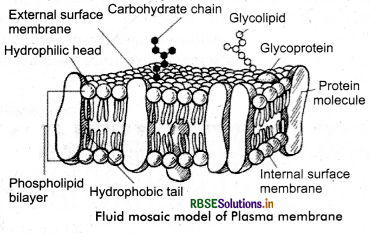
Functions of Plasma Membrane
The cell membrane serves following functions:
1. The cell membrane provides mechanical support to the cell.
2. It maintains the shape of the cell.
3. It protects the cell from injury.
4. The cell membrane is selectively permeable and able to regulate what enters and exits the cell, thus facilitating the transport of material needed for survival. The movement of substances across the membrane can be either “passive”, occurring without the expenditure of cellular energy or “active”, requiring the cell to expend energy.
Passive Transport: It is the movement of ions and other atomic or molecular substances across cell membrane without expenditure of energy. The rate of passive transport depends on the permeability of the cell membrane, which is turn depend on the organization and characteristics of the membrane lipids and proteins. The four main kinds of passive transports :
(a) Diffusion (Simple): Movement of material from an area of its high concentration to the area of its low concentration along the concentration gradient.
(b) Facilitated Diffusion: Movement of material from an area of its lower concentration to the area of its higher concentration via specific transmembrane integral proteins.
(c) Filtration: Movement of molecules through semi - permeable membranes with pressure developed by external factors.
(d) Osmosis: Movement of solvent molecules (diffusion of water) from the region of its higher concentration to the region of its lower concentration through the semi permeable membrane.
Active Transport: Active transport is the movement of molecules across a membrane from a region of their higher concentration (against the concentration gradient). Active transport requires cellular energy to achieve this movement (Fig. 8.14).
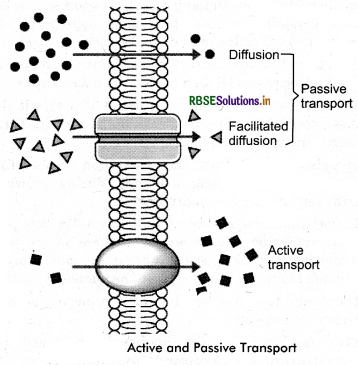
Question 6.
Write the difference between prokaryotic and eukaryotic cells.
Answer:
|
Characteristics |
Prokaryotic Cell |
Eukaryotic Cell |
|
1. Size |
1. Small |
1. Comparatively large |
|
2. Nucleus |
2. Primitive or incipient nucleus, also called as nucleoid or genophore. (i) It lacks nuclear membrane. (ii) It lacks nucleous. (iii) Genetic material DNA is not associated with histone proteins. |
2. Well developed and true nucleus is present. (i) It has nuclear membrane. (ii) it has nucleolus. (iii) Genetic material DNA is associated with histone proteins. |
|
3. Number of Chromosomes |
3. (i) One, but not true chromosome. (ii) Plasmid is present. |
3. (i) More than one chromosomes are present. (ii) Plasmid is absent. |
|
4. Cell Type |
4. Usually unicellular (some cyanobacteria may be multicellular). |
4. Usually multicellular. |
|
5. Membrane bound cell organelles |
5. Mitochondria, golgi apparatus, endoplasmic reticulum etc. present. |
5. There is no cell organelles except ribosome. |
|
6. Ribosomes |
6. Smaller, 70 S types. |
6. Larger, 80 S types. |
|
7. Lysosomes |
7. Absent |
7. Present. |
|
8. Cell division |
8. Mitosis and meiosis not occur. |
8. Mitosis and meiosis takes place. |
|
9. Respiratory system |
9. Present in plasma membrane. |
9. Present in mitochondria. |
|
10. Photosynthetic system |
10. Present in lamellae. |
10. Present in plastids. But absent in animal cells. |
|
11. Flagella |
11. Flagella are composed of microfibrils and lack 9+2 arrangement. |
11. Flagella are composed of microtubules and 9 + 2 arrangement occurs. |
|
12. Capsule |
12. May be present. |
12. Absent. |
|
13. Sexual Reproduction |
13. Absent or sometime occurs. |
13. Well developed. |
|
14. Genetic recombination. |
14. Partial, undirectional transfer. |
14. Meiosis and fusion of gametes. |
|
15. Microtubules Example: |
15. Absent or rare Bacteria, blue green algae (Cyanobacteria and Mycoplasma). |
15. Present Protists, Fungi, Plantae and Animalia. |
Question 7.
What are microtubules? Write their functions.
Answer:
Microtubules: These can be observed only with the help of electron microscope. These were first observed in 1953 by Robertis and Franchi in the axons of medulated nerve fibres. These are cylindrical tubules, 20 - 25 nm in diameter. They are composed of subunits of the protein tubulin. These subunits are termed α - tubulin and ß - tubulin.
Functions
- Microtubules act as a scaffold to determine cell shape.
- They provide a set of “tracks” for cell organelles and vesicles to move on.
- Microtubules also form the spindle fibres for separating chromosomes during mitosis.
- When arranged in geometric patterns inside flagella and cilia, they are used for locomotion.
- Microtubules causes movement of pigment granules in the chromatophores.
- Microtubules are components of centrioles and basal bodies.
Question 8.
Illustrate the difference between 70S and 80S ribosomes.
Answer:
|
80S Ribosomes |
70S Ribosomes |
|
1. They occur only eukaryotic cells. |
1. These are found both in prokaryotes and eukaryotes. |
|
2. They occur inside cytoplasm of eukaryotes either freely or attached to ER. |
2. The ribosomes are found freely inside the cytoplasm of prokaryotes and matrix of plastids and mitochondria of eukaryotes. |
|
3. The ribosomes are larger in size with a length of (300 - 400 A) and breadth (200 - 240 A). |
3. They are comparatively smaller with a length of 200 - 290 Å and a diameter of 170 - 210 Å. |
|
4. The sedimentation coefficient is 80. |
4. The sedimentation coefficient is 70. |
|
5. They are comparatively heavier, 4.0 - 4.5 million altons. |
5. These are comparatively lighter, 2.7 - 3.0 million daltons. |
|
6. The two sub units are 40S and 60S. |
6. The two sub units are 30s and 50s. |
|
7. The rRNA of 80S ribosomes are 28S + 5.8S + 5S in larger subunit and 18S in smaller subunit. |
7. The rRNAs of 70S ribosomes are 23S + 5S (larger subunit) and 16S (smaller subunit). |
|
8. The ribosomes possess less of rRNA as compared to protein (40 : 60). |
8. The ribosomes contain more of rRNA than protein (60 : 40). |
|
9. 80S ribosomes are synthesized inside the nucleolus. |
9. 70S ribosomes are synthesized in the cytoplasm of prokaryotes and matrix of semi autonomous |
|
10. It contains about 73 protein molecules, 40 in larger subunit and 33 in smaller subunit. |
10. It possesses about 55 protein molecules, 34 in larger subunit and 21 in smaller subunit. |
|
11. Protein synthesis is not inhibited by common antibiotics like chloramphenicol. |
11.Protein synthesis is inhibited by antibiotics like chloramphenicol. |
Question 9.
Mention the difference between heterochromatin and euchromatin.
Answer:
|
Heterochromatin |
Euchromatin |
|
1. They are tightly packed with high DNA density. |
1. They are loosely packed with low DNA density. |
|
2. They are darkly stained. |
2. They are lightly stained. |
|
3. They are found at the periphery of the nucleus in eukaryotic cells. |
3. They are found in the inner body of the nucleus of prokaryotic as well as eukaryotic cells. |
|
4. They/ show little or no transcriptional activity. |
4. They are transcriptionally active. |
|
5. They are compactly coiled. |
5. They are loosely coiled. |
Question 10.
Give the scientific terms for the following:
(a) Cluster of ribosomes found in cytoplasm.
(b) Extensive infolding to the inner membrane of mitochondria.
(c) Stacks of closely packed thylakoids.
(d) Stalked particles on the inner membrane of mitochondria.
Answer:
(a) Polysome
(b) Cristae
(c) Grana
(d) F0 - F1 particles.

Question 11.
Draw a figure of ultrastructure of centriole as seen in transverse section.
Answer:
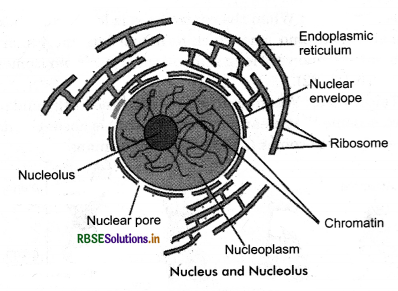
Question 12.
Mention the main difference between plant cell and animal cell.
Answer:
|
Characteristics |
Plant Cell |
Animal Cell |
|
1. Cell wall |
1. Present, mainly made up of cellulose. |
1. Cell wall is absent. |
|
2. Plastids |
2. Three types of plastids present in the cytoplasm. |
2. Plastids are absent. |
|
3. Vacuoles |
3. One large central vacuole taking upto 90% cell volume. |
3. Small vacuoles (much smaller than plant cells). |
|
4. Centrosome |
4. Plant cells lack centrosome except some lower plant forms like algae (Chlamydomonas). |
4. Present in all animal cells. |
|
5. Lysosome |
5. Lysosomes usually not evident except some plant cells. |
5. Lysosomes occur in cytoplasm. |
|
6. Microvilli |
6. Absent. |
6. May be present. |
|
7. Cytokinesis |
7. Division of cytoplasm takes place by forming a cell plate between two separating daughter cells. |
7. Division of cytoplasm (cytokinesis) takes place by forming a constriction in cell membrane between two separating daughter cells. |
|
8. Reserve food Material |
8. Stored in the form of starch (a polysaccharide). |
8. Stored in the form of mostly glycogen (a poly saccharide) and fat. |
Question 13.
Discuss the main functions of plasma membrane.
Answer:
The cell membrane serves following functions:
1. The cell membrane provides mechanical support to the cell.
2. It maintains the shape of the cell.
3. It protects the cell from injury.
4. The cell membrane is selectively permeable and able to regulate what enters and exits the cell, thus facilitating the transport of material needed for survival. The movement of substances across the membrane can be either “passive”, occurring without the expenditure of cellular energy or “active”, requiring the cell to expend energy.
Passive Transport: It is the movement of ions and other atomic or molecular substances across cell membrane without expenditure of energy. The rate of passive
transport depends on the permeability of the cell membrane, which is turn depend on the organization and characteristics of the membrane lipids and proteins. The four main kinds of passive transports:
(a) Diffusion (Simple): Movement of material from an area of its high concentration to the area of its low concentration along the concentration gradient.
(b) Facilitated Diffusion: Movement of material from an area of its lower concentration to the area of its higher concentration via specific transmembrane integral proteins.
(c) Filtration: Movement of molecules through semi - permeable membranes with pressure developed by external factors.
(d) Osmosis: Movement of solvent molecules (diffusion of water) from the region of its higher concentration to the region of its lower concentration through the semi permeable membrane.
Question 14.
What are raphides and innulin?
Answer:
Raphides: The organic wastes that occur in the form of crystals of calcium oxalate in some leaves of plant like Gulmehndi plant.
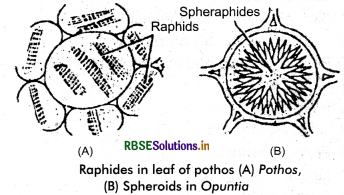
In Colocasia and Opuntia they form star shaped structure and called spheroides.
Innulin : These are soluble polysaccharides occurs as stored food in the roots of Dehalia. It is insoluble in alcohol and glycerine.
Long Answer Type Questions
Question 1.
Discuss a detail account of the structure of cell wall giving diagram.
Answer:
The cell wall is the outer covering of a cell, present adjacent to the cell membrane (plasma membrane). As mentioned earlier, the cell wall is present in all plant cells, fungi, bacteria, algae and some archaea. An animal cell is irregular in their shape and this is mainly due to the lack of cell wall in their cells. The composition of the cell wall usually vary along with organisms. In algae, the cell wall is made up of cellulose, galactans, mannans and minerals like calcium carbonate. The plant cell wall is generally arranged in three layers and composed of carbohydrates like pectin, cellulose, hemicellulose and other smaller amount of minerals, which form a network along with structural proteins to form the cell wall. The three major layers are:
- The middle lamella.
- Primary cell wall.
- The secondary cell wall.
1. Middle lamella: The middle lamella is outermost layer and it acts as an interface between the other neighbouring cells and glues them together. This layer primarily consists of pectins. However, other substances such as lignin and proteins can also be found.
2. Primary cell wall: The primary cell wall is situated closest to the inside middle lamella and is the first formed cell wall. It is mainly made up of cellulose, allowing the wall to stretch for the purpose of growth. Several primary cell walls contain piectic polysaccharides and structural proteins. It is also comparatively permeable and thinner than the other layers.
3. Secondary cell wall: The secondary cell wall is formed inside the primary cell wall once the cell is completely grown. Some type of cells (especially the cells of xylem tissues) consists of cellulose and lignin and these provide additional rigidity and water proofing. Also, this layer provides the characteristic rectangular or square shape to a cell. It is thickest layer and permits permeability.
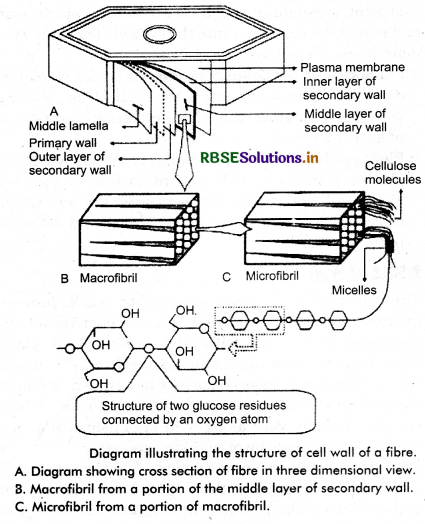
Question 2.
Describe the electron microscopic structure of chloroplast with figure.
Answer:
Chloroplasts are found in all higher plants. It is oval or biconvex, found within the mesophyll of the plant cell. The size of the chloroplast usually varies between 4 - 6 µm in diameter and 1 - 3 µm in thickness. They are double - membrane organelle with the presence of outer, inner and intermembrane space. There are two distinct regions present inside a chloroplast known as the grana and stroma.
Grana are made up of stacks of disc - shaped structures known as thylakoids or lamellae. The grana of the chloroplast consists of chlorophyll pigments and are the functional units of chloroplasts.
Stroma is the homogenous matrix which contains grana and is similar to the cytoplasm in cells in which all the organelles are embedded. Stroma also contains various enzymes, DNA, ribosomes, and other substances. Stroma lamellae function by connecting the stacks of thylakoid sacs or grana.
The chloroplast structure consists of the following parts:
Membrane Envelope
It comprises inner and outer lipid bilayer membranes. The inner membrane separates the stroma from the intermembrane space.
Intermembrane Space
The space between inner and outer membranes.
Thylakoid System (Lamellae)
The system is suspended in the stroma. It is a collection of membranous sacs called thylakoids or lamellae. The green coloured pigments called chlorophyll are found in the thylakoid membranes. It is the sight for the process of light-dependent reactions of the photosynthesis process. The thylakoids are arranged in stacks known as grana and each granum contains around 10-20 thylakoids.
Stroma
It is a colourless, alkaline, aqueous, protein-rich fluid present within the inner membrane of the chloroplast present surrounding the grana.
Grana
Stack of lamellae in plastids is known as grana. These are the sites of conversion of light energy into chemical energy.
Chlorophyll
It is a green photosynthetic pigment that helps in the process of photosynthesis.
Also read: Light-dependent Reactions
Functions of Chloroplast
Following are the important chloroplast functions:
The most important function of the chloroplast is to synthesise food by the process of photosynthesis.
Absorbs light energy and converts it into chemical energy.
Chloroplast has a structure called chlorophyll which functions by trapping the solar energy and is used for the synthesis of food in all green plants.
Produces NADPH and molecular oxygen (O2) by photolysis of water.
Produces ATP – Adenosine triphosphate by the process of photosynthesis.
The carbon dioxide (CO2) obtained from the air is used to generate carbon and sugar during the Calvin Cycle or dark reaction of photosynthesis.


Question 3.
Give an account of ultrastructure of a cilium and flagellum.
Answer:
The electron microscopic study of a cilium or the flagellum show that they are covered with plasma membrane. Their core called axonema which is about 2-10 pm long in cilia and about 150 pm long in flagella. The axoneme is composed of 11 microtubules. Out of these two microtubules are single and lie at the centre with a gap between. They are called central singlets. They are connected together by a double bridge. They are surrounded by a common central sheath. The remaining 09 microtubules are double and lie in a ring around the central microtubules. The one tubule of the each peripheral doublet is connected with central sheath by a radial spoke. Thus, there are nine radial spokes that connect the peripheral doublets with central sheath (the covering of centrally located single microtubules or singlets). This arrangement of axonemal microtubules is also called 9+2 arrangement. In non motile or primary cilia, the two central single microtubules are absent so the central bundle consists of 9 + 0 arrangement of microtubules.
In prokaryotic cells, the flagella are filamentous protein structures composed of flagellin. The peripheral doublets are also interconnected by linkers. Both the cilium and flagellum emerge from centriole like structure called basal bodies.
Chemical Structure: The microtubules (single or double) are made up of tubulin protein. The arm of one microtubule (of each peripheral doublet) contain a protein dynein which converts the chemical energy stored in ATP to mechanical work. The linkers of interlinking the doublets are made up of nexin. The radial spokes and central sheath are formed of protein of unknown nature.
Types of Flagella:
1. Whiplash or Acronematic flagellum: When flagellar membrane has no hairs on its surface, it is called whiplash or acronematic flagellum.
2. Tinsel or Pantonematic flagellum: When flagellar membrane has stiff hairs (called flimmer filaments) on its surface, it is called tinsel or flimmergeissel flagellum.
Types of Cilia:
1. Non - motile or Primary cilia: These are found in nearly every cell in all mammals and as the name suggests these do not beat. They can be found in human sensory organs such as eye and the nose.
2. Motile cilia: These are found on the surface of cells and they beat in a rhythmic manner. They can be found in the lining of trachea (windpipe), where they sweep mucus and dirt out of the lungs. In female mammals, the beating of cilia in the fallopian tubes moves the ovum from the ovary to the uterus.
Question 4.
Give a detail account of the structure and function of E.R. with figures.
Answer:
The endoplasmic reticulum transpires in two forms: a type with a ribosome-studded surface and another with a smooth surface. The latter is called the smooth endoplasmic reticulum, and the former is called the rough endoplasmic reticulum. These membranes form continuous folds, eventually joining the outer layer of the nuclear membrane. Except for sperm cells and red blood cells, the endoplasmic reticulum is observed in every other type of eukaryotic cell.
Endoplasmic Reticulum Diagram
The below diagram shows the variants of the endoplasmic reticulum:
Rough ER
Smooth ER
Rough endoplasmic reticulum has ribosomes embedded within its structure, giving a “rough” appearance. The smooth endoplasmic reticulum does not have these ribosomes, hence appearing “smooth.”
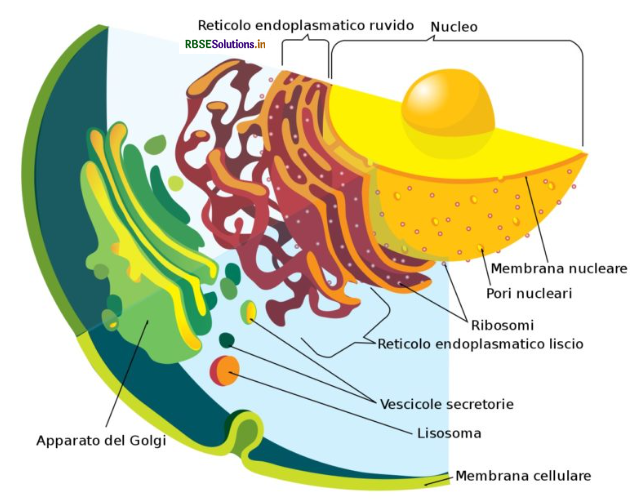
Structure of Endoplasmic Reticulum
The structure of the endoplasmic reticulum is shaped like a sac. Since ER is of two types, each has its own distinguishing features:
Rough Endoplasmic Reticulum Structure
- The rough endoplasmic reticulum is named so because of its appearance.
- It is a series of connected flattened sacs having several ribosomes on its outer surface, hence the name.
- It synthesizes and secretes proteins in the liver, hormones and other substances in the glands.
- Rough ER is prominent in cells where protein synthesis happens (such as hepatocytes)
Smooth Endoplasmic Reticulum Structure
- The smooth endoplasmic reticulum, on the other hand, does not have ribosomes.
- The smooth endoplasmic reticulum has a tubular form.
- It participates in the production of phospholipids, the chief lipids in cell membranes and are essential in the process of metabolism.
- Smooth ER transports the products of the rough ER to other cellular organelles, especially the Golgi apparatus.
Question 5.
What are chromosomes? Discuss their biochemical structure and types with figures.
Answer:
(Chroma = colour, soma = body)
The chromosomes were first described by Strausberger in 1875. The term “chromosome” however was first used by Waldeyer in 1888. The chromatin fibres become condense to form short, thick, thread like structures called chromosomes during the dividing phase of cell cycle. Chemically the metaphase chromosomes contain 15 - 20% DNA, 10 - 15% RNA and 65 - 75% proteins.

A single human cell has approximately two meter long thread of DNA distributed among its forty six (23 pairs) chromosomes.
Structure of Chromosome: Typically a chromosome is made. up of two chromatids, a centromere and a secondary constriction. Sister chromatids are two identical copies of chromosome connected by a centromere. The two chromatids of one homologous chromosome with respect to those of the other homologue are called nonsister chromatids. The region where two sister chromatids of a chromosome appear to be joined during cell division is called centromere which is also termed as primary constriction. The chromosomes may have additional constrictions termed secondary constrictions near their ends. Parts of the chromosome beyond the secondary constriction is termed satellite. The protein structures on the sides of centromere where the spindle fibres attach during cell division to pull the chromosomes apart, are called kinetochore.
Types of Chromosomes: Each chromosome can be divided into two parts (p and q arms) with a constriction point called a centromere in the middle. However, the
centromere can be located in different positions and this forms the basis for the four different types of chromosome.
- Metacentric: When centromere is located in middle that means p and q arms are of comparable length (e.g., chromosomes 1, 3, 16, 19, 20).
- Submetacentric: When the centromere is located slightly away from the middle. In these chromosomes, p arm is shorter than q arm (e.g., chromosomes 2, 4,12,17, 18).
- Acrocentric: When the centromere is located close to the end of chromosome which form one extremely short (p arm) and one very long arm (q arm) e.g., chromosomes 13 to 15, 21, 22.
- Telocentric: When centromere is located at the end of chromosome that means one arm (p arm) is absent. This type of chromosomes are not found in humans.
